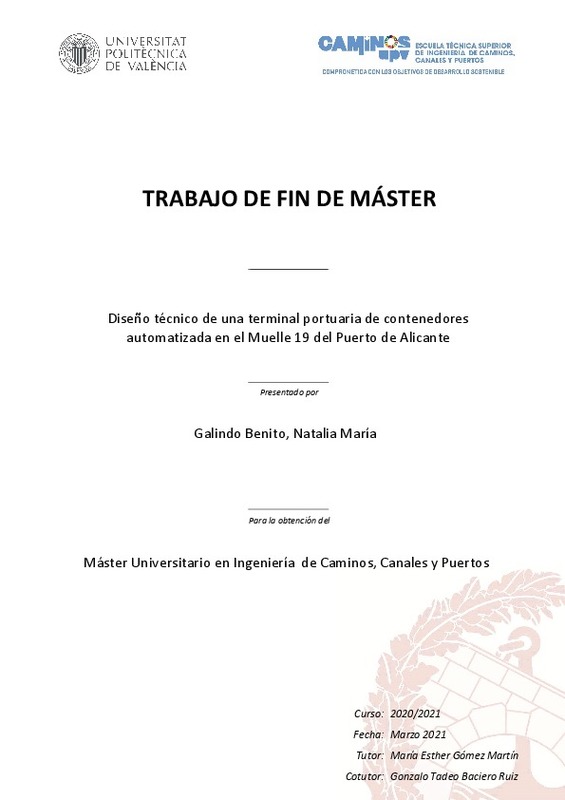|
Resumen:
|
[ES] Los puertos constituyen un punto estratégico importante para la realización del transporte logístico tanto terrestre como marítimo. En concreto, el tráfico de contenedores representa el 17,1% del comercio marítimo ...[+]
[ES] Los puertos constituyen un punto estratégico importante para la realización del transporte logístico tanto terrestre como marítimo. En concreto, el tráfico de contenedores representa el 17,1% del comercio marítimo total. La tendencia a la automatización de las terminales de contenedores sigue al alza, desde que, en 1993, la terminal ECT del puerto de Rotterdam abriera el camino a la búsqueda de puertos más sostenibles y más eficientes, mejorando la capacidad de la terminal, disminuyendo el consumo de energía de los equipos y aumentando la seguridad. Tras 27 años, el desarrollo de la ciencia y la innovación tecnológica junto con la demanda del desarrollo del mercado marítimo, ha conseguido que 50 terminales de contenedores del mundo ya hayan automatizado gran parte de los subsistemas.
Los principales beneficios que aporta la automatización es la reducción de costes por contenedor manipulado, ya que el personal necesario se reduce considerablemente, se aumenta la fiabilidad, la previsibilidad y la seguridad en las operaciones. Además, disminuye la huella de carbono emitida por el puerto al mejorar y optimizar los procesos y gracias al uso de maquinaria eléctrica. La automatización ayuda a optimizar las operaciones a escala global, minimizando la operación de la máquina, los desplazamiento en vacío, remociones, etc., lo que afecta directamente a la reducción del consumo de energía.
El objeto de este proyecto se centra en realizar el diseño técnico de una terminal portuaria de contenedores automatizada en el Muelle 19 de la Dársena Sur del Puerto de Alicante, con el fin de captar un mayor tráfico de contenedores tanto import/export como de transbordo, obteniendo rendimientos más eficientes que los actuales y utilizando menos recursos de mano de obra operativa. Para ello se analizan entre otros aspectos: la oferta y demanda, la evolución del tráfico de contenedores, el buque de proyecto, los niveles de automatización, las capacidades de los distintos subsistemas de la terminal (puerta marítima, almacenamiento, interconexión y puerta terrestre), el diseño en planta y alzado de la línea de atraque en función del buque de proyecto y las grúas de muelle, el dimensionamiento del patio de almacenamiento, el subsistema de interconexión, así como las necesidades de accesos terrestres, entre otros. Además, se realiza un estudio económico para conocer la viabilidad de este tipo de terminal y si permitirá un ahorro de costes de explotación suficiente para obtener mayores beneficios que una terminal convencional.
[-]
[EN] Ports are an important strategic point for the realization of both land and sea logistics transport. Specifically, container traffic represents 17.1% of total maritime trade. The trend towards the automation of container ...[+]
[EN] Ports are an important strategic point for the realization of both land and sea logistics transport. Specifically, container traffic represents 17.1% of total maritime trade. The trend towards the automation of container terminals continues to rise, since, in 1993, the ECT terminal of the port of Rotterdam opened the way to the search for more sustainable and efficient ports, improving the capacity of the terminal, reducing the energy consumption of equipment and increasing safety. After 27 years, the development of science and technological innovation together with the demand of the development of the maritime market, has achieved that 50 container terminals in the world have already automated a large part of the subsystems.
The main benefits of automation is the reduction of costs per container handled, since the necessary personnel is considerably reduced, reliability, predictability and safety in operations are increased. In addition, it reduces the carbon footprint emitted by the port by improving and optimizing processes and thanks to the use of electrical machinery. Automation helps to optimize operations on a global scale, minimizing machine operation, idling, removals, etc., which directly affects the reduction of energy consumption.
The purpose of this project is to carry out the technical design of an automated container port terminal at Pier 19 of the South Dock of the Port of Alicante, in order to capture greater container traffic, both import / export and transshipment, obtaining more efficient yields than the current ones and using fewer resources of operational manpower. For this, among other aspects, the following are analyzed: supply and demand, the evolution of container traffic, the project ship, the levels of automation, the capacities of the different subsystems of the terminal (maritime gate, storage, interconnection and land gate), the plan and elevation design of the mooring line based on the project ship and the quay cranes, the sizing of the storage yard, the interconnection subsystem, as well as the needs for land accesses, among others. In addition, an economic study is carried out to determine the viability of this type of terminal and whether it will allow sufficient operating cost savings to obtain greater benefits than a conventional terminal.
[-]
|







